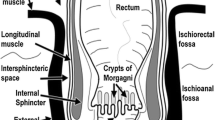Abstract
Background: There are no clinical or laboratory tests that can eliminate the possibility of appendicitis in a child with abdominal pain that suggests the diagnosis. The standard of care is to admit these children to the hospital for observation. More than twice as many children hospitalized for abdominal pain suggesting appendicitis are subsequently sent home after observation compared to those who undergo appendectomy. Objective: To evaluate the ability of CT with rectal contrast medium (CTRC) to diagnose a normal appendix in children with abdominal pain. Materials and methods: A prospective cohort study in an urban pediatric emergency department. Children 6–17 years of age with abdominal pain were eligible when the attending physician planned to admit them for observation for possible appendicitis. All 94 patients underwent CTRC. CTRC results were compared to patient outcomes. Results: Ninety-four children successfully underwent CTRC. Among the 53 patients with reflux of contrast medium into the ileum, the appendix was visualized in 43 (81.1%). Among all 94 cases, the appendix was visualized in 53 cases (55.7%); 43 studies were read as normal, and 10 showed appendicitis. Of the 43 with a normal appendix, 23 were discharged home, 18 were admitted but discharged uneventfully, and two underwent surgery for another diagnosis. When the appendix was visualized, the sensitivity, specificity, and negative and positive predictive values of CTRC were 100% (95% CI 66.4, 100.0), 97.7% (95% CI 88.0, 99.9), 100% (95% CI 91.8, 100.0), and 90% (95% CI 55.5, 99.8), respectively. The use of CTRC could have decreased the admission rate for observation for appendicitis by at least 41.8% and by more than 80% when the appendix could be seen. Conclusion: Our data suggest that when the appendix can be visualized, CTRC can accurately identify a normal appendix and reduce the number of children hospitalized for observation for possible appendicitis.





Similar content being viewed by others
References
Rothrock SG, Pagane J (2000) Acute appendicitis in children: emergency department diagnosis and management. Ann Emerg Med 36:39–49
Reynolds SL, Jaffe DM (1992) Diagnosing abdominal pain in a pediatric emergency department. Pediatr Emerg Care 8:126–128
Mollit DL, Mitchum D, Tepas III JJ (1988) Pediatric appendicitis: efficacy of laboratory and radiologic evaluation. South Med J 81:1477–1479
Department of Health and Human Services (2001) 1999 National Hospital Discharge survey: annual summary with detailed diagnosis and procedure data; Series 13, no 151, pp 21, 30, 38
Rao PM, Rhea JT, Novelline RA, et al (1998) Effect of computed tomography of the appendix on treatment of patients and use of hospital resources. N Engl J Med 338:141–146
Garcia Pena BM, Mandl KD, Kraus SJ, et al (1999) Ultrasonography and limited computed tomography in the diagnosis and management of appendicitis in children. JAMA 282:1041–1046
Garcia Pena BM, Taylor GA, Fishman SJ, et al (2000) Costs and effectiveness of ultrasonography and limited computed tomography for diagnosing appendicitis in children. Pediatrics 106:672–676
Garcia Pena BM, Taylor GA, Lund DP, et al (1999) Effect of computed tomography on patient management and costs in children with suspected appendicitis. Pediatrics 104:440–446
Garcia Pena BM, Cook EF, Mandl KD (2004) Selective imaging strategies for the diagnosis of appendicitis in children. Pediatrics 113:24–28
Hernandez RJ (1979) Capacity of the colon in children. AJR 133:683–684
Nikolaidis P, Hwang CM, Miller FH, et al (2004) The nonvisualized appendix: incidence of acute appendicitis when secondary inflammatory changes are absent. AJR 183:889–892
Fletcher RH, Fletcher SW, Wagner EH (1988) Clinical epidemiology: the essentials, 2nd edn. Williams and Wilkins, Baltimore, p 55
Bachoo P, Mahomed AA, Ninan GK, et al (2001) Acute appendicitis: the continuing role for active observation. Pediatr Surg Int 17:125–128
Barber MD, McLaren J, Rainey JB (1997) Recurrent appendicitis. Br J Surg 84:110–112
Lowe LH, Perez R Jr, Scheker LE, et al (2001) Appendicitis and alternate diagnoses in children: findings on unenhanced limited helical CT. Pediatr Radiol 31:569–577
Kosloske AM, Love CL, Rohrer JE, et al (2004) The diagnosis of appendicitis in children: outcomes of a strategy based on pediatric surgical evaluation. Pediatrics 113:29–34
Brenner DJ, Elliston CD, Hall EJ, et al (2001) Estimated risks of radiation-induced fatal cancer from pediatric CT. AJR 176:289–296
Author information
Authors and Affiliations
Corresponding author
Rights and permissions
About this article
Cite this article
Acosta, R., Crain, E.F. & Goldman, H.S. CT can reduce hospitalization for observation in children with suspected appendicitis. Pediatr Radiol 35, 495–500 (2005). https://doi.org/10.1007/s00247-004-1384-4
Received:
Revised:
Accepted:
Published:
Issue Date:
DOI: https://doi.org/10.1007/s00247-004-1384-4




